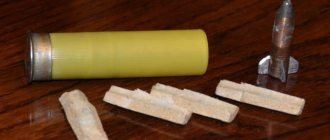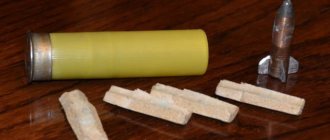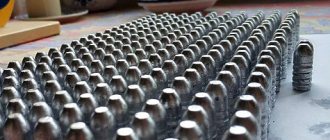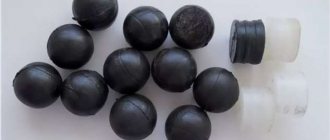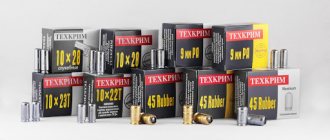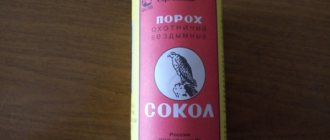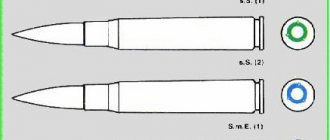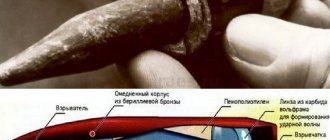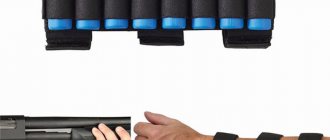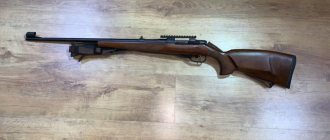Nowadays, hunting stores offer a large selection of bullets for smooth-bore hunting rifles, both in the form of ready-made loaded hunting cartridges, and in the form of bullets for independent equipment.
It is difficult for an ordinary hunter to understand among such a large assortment of bullets, which differ in their modifications and characteristics.
The hunter most often comes to everything with his own mind, based on his experience, and having chosen a certain bullet, decides on it, gets used to using it and no longer changes his preferences. Many hunters chose Polev bullets.
Polev's bullets are well known to hunters in Russia and throughout the former Soviet Union and are often used by them when hunting large animals. Polev's bullets have always shown good results: high accuracy, good stopping effect when shooting at ungulates.
The first of these bullets, now called Polev Bullet 1, was developed back in the 1980s by Viktor Vladimirovich Polev.
The reason for the development of these bullets was the fact that in those days rifled weapons were not available to a wide range of hunters; most hunters had smooth-bore guns, but there were no good, high-quality bullets for them that could be used when hunting big game. The bullets produced at that time did not perform well.
Characteristics of Polev bullets
There are many varieties of Polev bullets for smoothbore weapons of different calibers, these are bullets such as: Polev 1 bullet, Polev 2 bullet, Polev 3 bullet, Polev 6 bullet, Polev 6U bullet.
Each brand of bullet from the Polev bullet family has its own characteristics, so it cannot be said that one of the Polev bullets is better than others. Each of them, according to its characteristics, is better suited for certain game and certain hunting conditions.
According to Polev himself, a different assortment of bullets is needed, both light and heavy, both expansive and non-expansive.
For each gun, it is necessary to select bullets that could provide the best convergence of the average points of impact from each barrel.
Many factors influence the toss of a bullet, including the angle of the butt plate, the correctness and strength of the shoulder rest, the rotation of the gun relative to the center of mass, and the force of recoil.
Each gun will have its own bullet, with its own characteristics. Which one - heavy or light - is better to hit the animal, this question is decided by the hunter himself.
Polev bullet 1 12 gauge
The first of the bullets developed by Polevy. In appearance, it is an arrow-shaped, pointed lead bullet weighing 31.8 grams.
What sets it apart from many other bullets is the presence of a plastic shank wad that attaches to the rear of the bullet. Functions of the wad-shank: serves as a wad seal in the cartridge and stabilizes the bullet in flight. Inside the wad-shank there are helical grooves that seem to screw the bullet into the wad, this is done so that the stabilizer does not come off the bullet in flight.
The bullet itself is in a plastic container consisting of two halves, which, according to the designer, are separated from the bullet when it leaves the barrel. In flight, the Polev 1 bullet resembles a rocket with stabilizers.
The dispersion diameter of the Polev 1 bullet at 50 m with the correct equipment is on average about 6 cm, and the bullet flew equally well from barrels with different choke constrictions, right up to the choke.
The Polev bullet has high accuracy and range. With its mass of 31.8 grams, the Polev 1 bullet turned out to be quite heavy, which could not affect shooting.
According to reviews from hunters, the Polev 1 bullet, when fired from some guns, can give poor accuracy and often hits the target below the aiming point.
1.8.6.4. Polev's bullet
1.8.6.4. Polev's bullet
It also consists of two parts - head and tail.
The head part is drop-shaped, pointed, with a skirt, the tail part is in the form of a lead rod more than half the length of a bullet. The center of gravity is shifted towards the head. A polyethylene wad-stabilizer is attached to the tail elongated part, which gives the bullet rotation and does not separate when it leaves the barrel ( Fig. 18.A
). The length of the stabilizer is equal to the length of the bullet. A special feature is that a strong and reliable connection of the head with the stabilizer occurs during the shot due to the deformation of the lead head resulting from overloads during acceleration. Before the shot is fired, the bullet does not sit very tightly in the stabilizer; it can rotate and be pulled out. The bullet has a simple design and does not have guide ribs. Passage through a choke-type choke is ensured by a plastic container, a polyethylene stabilizer and the fact that the diameter of the bullet is 2.5 m smaller than the diameter of the wad. The presence of a plastic container simplifies the loading of the cartridge. Both halves of the container separate immediately after leaving the barrel, and the wad-stabilizer often remains on the outside of the target, since it has a significantly larger diameter than the diameter of the lead bullet body (for 12 gauge 18.3 mm versus 15.8 mm) .
Rice. 18. Bullet Polev:
A - Polev bullet: 1 - bullet body, 2 - stabilizer, 3 - container of 2 halves;
B - Polev bullet, modified by V. Blokhin: 1 - expansive void, 2 - M5 threaded rod, 3 - threaded hole, 4 - stabilizer
The bullet is distinguished by its high flight speed compared to bullets from Mayer, Sputnik, Kirovchanka, Yakan, etc., as well as combat accuracy: the spread of bullets at a distance of 50 m is 65–112 mm, subject to equipment recommendations. The bullet, however, is light in weight - the weight of a 12-gauge lead bullet body without stabilizer is 26.5 g - which corresponds to the normal weight of a 20-gauge bullet. Therefore, the stopping effect of the Polev bullet is lower than that of Brenneke-type bullets and Rubeykin bullets. Nevertheless, the lethality of the bullet is high due to its high speed. The 12 or 16 gauge is indicated on the bottom of the stabilizer wad.
Let us present some technical data about this 12-gauge bullet, set out in an article by N. Aleksandrov (OiOKh, No. 10, 1994). The figures are indicated for original and serial samples of 12 gauge, respectively: bullet mass, g - 30.8+0.2/28±0.2; mass of the damaging element - 27.8±0.2/24.5±0.2; weight of “Falcon” gunpowder, g. - 2.1/2.1; flight speed at a distance of 50 m, m/s - 312±4/325+6; dispersion diameter at 50 m, cm - 6.5/6.6. The bullet is good for shooting medium-sized ungulates.
A second model of the Polev bullet with an expansive void in the head has been developed. It is significantly superior to other models of bullets available to the bulk of hunters in terms of accuracy, range and damaging effect, but, like any hollow bullet, it is afraid of thickets. In general, the Polev bullet of the second model can be recommended for hunting medium and large animals in more or less open places.
To enhance the stopping effect and simplify its production at home, V. Blyakhin (OiOKH, No. 11, 1991) offers the following modification. The bullets he made ( Fig. 18.B
) are lengthened due to the wad-stabilizer in such a way that when they are equipped with cartridges for rolling, no more than 3mm of the case tube remains.
The stabilizer wads have six straight guide ribs with flat top ends instead of the nine inclined ones in the original. At the bottom of the blind hole of the wad-stabilizer there is a rod with an M5 thread, which, when assembling the bullet, is screwed into the threaded hole of the shank (central rod) of the lead part of the bullet, thereby achieving a reliable connection between them. The top of the bullet is cut perpendicularly with an expansive void in it 8 mm deep ( Fig. 18B
). The weight of such a 12-gauge bullet assembled with a wad-stabilizer is 33–33.4 g, the weight of the container is 1.9 g. When fired, the thread on the rod is cut off and then all the processes characteristic of a Polev bullet occur. To make it easier to roll the skirt of the lead part of the bullet into the neck of the wad-stabilizer, its thickness is reduced to 1.5 mm, and the edge is made at an angle of 45°.
Field bullet 2 12 gauge
The Polev 2 12 gauge bullet was developed based on the experience gained when creating the Polev 1 bullet. The weight of the Polev 2 bullet was reduced by more than 3 grams and amounted to 28 grams. The shape of the bullet itself was also changed; it became narrower and longer than its predecessor.
The wad-shank was seriously changed; instead of helical grooves, it became a shank with six blades.
Due to changes made to the design of the bullet, its speed increased to 450 m/s. Thanks to this, the bullet has become more accurate; during factory tests, the spread at 100 meters was 8 cm, and at 200 meters - 20 cm. For smooth-bore weapon bullets, this is a very good result.
According to hunters' reviews, the Polev 1 bullet and the Polev 2 bullet had one significant drawback; they both had a low stopping effect. When fired, the bullet pierced the animal through and through, without stopping the animal.
Solengo - The bullet is loaded into a 70 mm transparent plastic sleeve. It bears the Gothic inscriptions “Palla Solengo” and “Super express expansive”.
large squares, green. Doesn't fit tightly in the sleeve.
Accuracy - 160 mm. The lift of one bullet is 140 mm. to the left. Not overwhelmed. The Italians did not charm. The Salengo bullet, in a series of 3 shots, showed good accuracy - good accuracy: 1 bullet - at 9 at 3 o'clock, 2 bullets - at 8 at 13 o'clock, although the holes are oval-shaped. The scatter diameter is 14 cm. {Experiment 5} Solengo Magnum - The bullet is equipped with a 76 mm red plastic sleeve. On it are inscriptions in the Gothic style: “Palla Solengo”, “Super express expansive” and “Magnum 76/***28gr.”
large squares, green and red. Doesn't fit tightly in the sleeve. "Salenga" Magnum (28 gr.) - a series of 3 shots. It’s strange that by writing magnum on the cartridge case, they didn’t increase the weight of the bullet. It does not fall out of the results of its more famous brothers. The results are as follows - 2 bullets overlapped each other at 11 o’clock, one bullet at 12:30. The holes are smooth, oval in shape. The bullet goes along the horizon. The dispersion diameter is 7 cm. {Experiment 4} Trio - The bullet is loaded into a yellow 70 mm sleeve with a logo and an image of a wild boar. There is also the inscription "NITROGEN" and "Bullet Trio". "Trio" Azot - a series of 3 shots. On the target, all shots are marked with Roman numerals. Only from the first, all bullets hit the target. From the second there is only one, from the third there are two. The trend is grouping at 8 o'clock. The holes are smooth and round. We discussed the shooting result shown here for a long time. Our opinion is that if you maim and wound an animal, then it is possible, but if you hunt it, then it is not suitable for hunting. The dispersion diameter is more than 50 cm. {Experiment 4} Mancino/Maciza - The bullet is equipped with a yellow 70 mm sleeve with the inscription “Mancino/Maciza Bullet” with the company logo. The head part is spherical and sticks out of the plastic container. The entire bullet is sealed in plastic. The container is ribbed with two belts in the tail section. The design is original. Bullet weight 31.5 g. The container cannot be separated. The production is of high quality. Here are the photos.
. Gray-green gunpowder in the form of square and rectangular plates measuring ~2x2 mm. Bullet "Manzina" series of 3 shots. The result is not outstanding, but judging by the holes, the bullet is very stable in flight. Round holes 10, 9 at 13 o'clock, 8 at 22 o'clock. Dispersion diameter 13 cm. {Experiment 4}
The following group of bullets was purchased by the author from a very reputable dealer. Boxes made of thick paper. Inscriptions on all sides. There is even an equipment diagram. Only the inscription under it is mysterious: “Gunpowder according to 12 gauge standards.” On the other side is the name of the bullet, weight and quantity. Everything seems to match. But the weight of the “Chance” bullet turned out to be as much as 8 grams more. Either there was something wrong with the technology or there was just a mistake on the box. Then there is TU 1001115802.001-2001 and e-mail and the last inscription “Used for hunting and for sports and training purposes.” The actual production of the bullet is so clumsy that we decided to roll it through the barrel before loading it. So, “Blondeau” generally flies through the cylinder, and all the other bullets had to be carefully punched through it with a ramrod. Moreover, some would obviously damage the barrel during normal shooting. So we categorically do not recommend this product for use.
Vortex - Labels on the box “Recommended for use for shotguns with a tubular magazine. TU 100115802.001-2001. e-mail. Can only be used in guns with Paradox attachments or Paradox drill bits. For hunting and for sports and training purposes. Hunting bullet Paradox “Whirlwind” weight 33 grams” There is an equipment diagram with a unique inscription “Gunpowder according to 12 gauge standards.” We loaded the bullet in the following order. The sleeve is 70 mm, into it, on the gunpowder, we insert a special sub-bullet plastic wad seal, then we insert the bullet and roll it with a twist. So, we say a resounding NO to this bullet! Unlike its brother with the prefix M. We spent a long time looking for the third hole in the shield. Found. 10 centimeters in the leg of the shield. The flight of a bullet defies any logic. All the holes are in different places. Moreover, if you look closely, you can see that one bullet went exactly sideways. We categorically do not recommend this product for use. Dispersion 29 cm. {Experiment 5} Vikhr-M - Inscriptions on the box “Recommended for use for shotguns with a tubular magazine. TU 100115802.001-2001. e-mail. Can only be used in guns with Paradox attachments or Paradox drill bits. For hunting and for sports and training purposes. Hunting bullet Paradox Magnum “Vikhr-M” weight 34 grams” There is an equipment diagram with a unique inscription “Gunpowder according to 12 gauge standards.” We loaded the bullet in the following order. The sleeve is 70 mm, into it, on the gunpowder, we insert a special sub-bullet plastic wad seal, then we insert the bullet and roll it with a twist. To be honest, we did not expect such a result. We expected it to be much worse. There is normal grouping, a good vertical can be seen. The edges of the holes are quite clear. The spread is 10 cm.{Experience 5} POWER - The same, but the quality seems to be better. In my opinion, this is exactly what all the bullets of this group are molded to. The inscriptions on the box “Allowed for use in Magnum charges. TU 100115802.001-2001. e-mail. Has a powerful stopping effect. It is used for hunting large and dangerous animals, as well as for sports and training purposes. We wish you a successful hunt. Expansive hunting bullet “Power” weight 36 grams” There is an equipment diagram with a unique inscription “Gunpowder according to 12 gauge standards.” We loaded the bullet in the following order. The sleeve is 70 mm, into it, on the gunpowder, we insert a special sub-bullet plastic wad seal, then we insert the bullet and roll it with a twist. Here the accuracy matches the production. Large bullet separations from each other. Two bullets entered the target sideways. Spread 13 cm. {Experience 5} Lightning - Inscriptions on the box “Compliant with Magnum charge. TU 100115802.001-2001. e-mail. Can only be used in guns with Paradox attachments or Paradox drill bits. For hunting and for sports and training purposes. Hunting bullet Paradox expansive “Lightning” weight 36 grams” There is an equipment diagram with a unique inscription “Gunpowder according to 12 gauge standards.” It was not possible to load the bullet due to its failure to pass through the 18.8 bore. DANGEROUS! Teffer - We equipped the bullet in the following order. The sleeve is 70 mm, into it, on the gunpowder, we insert a special sub-bullet plastic wad seal, then we insert the bullet and roll it with a twist. Unfortunately, the weapon refused to break the primer of the cartridge case in which this type of bullet was assembled {Experiment 5} Teffer-SK - We loaded the bullet in the following order. The sleeve is 70 mm, into it, on the gunpowder, we insert a special sub-bullet plastic wad seal, then we insert the bullet and roll it with a twist. Unfortunately, the weapon refused to break the primer of the cartridge case in which this type of bullet was assembled {Experiment 5} PAM - The bullet could not be loaded due to its failure to pass through the 18.8 barrel bore. DANGEROUS! Moscow - We equipped the bullet in the following order. The sleeve is 70 mm, into it, on the gunpowder, we insert a special sub-bullet plastic wad seal, then we insert the bullet and roll it with a twist. It was a good looking bullet. Very high quality casting. Even the image of St. George the Victorious on the front. But the result is disastrous. Although the edges of the holes are clear. We categorically do not recommend this product for use. Spread 58 cm. {Experiment 5} Bullet of the “Brenne” type - 70 mm sleeve, into it, onto the gunpowder, we insert a special sub-bullet plastic wad seal, then we send the bullet and roll it with a twist. They make it in Klimovsk. Moreover, it looks better than the same bullet made in Kirov. This is the case when a good idea cannot be spoiled even by poor execution. The only negative is that the bullet is poorly stabilized. The holes are slightly oval. But most likely all this happens because of the wad, which is screwed on with a screw, and, as usual, crookedly. The spread is 8 cm. {Experiment 5} “Unknown No. 2” - We equipped the bullet in the following order. The sleeve is 70 mm, into it, on the gunpowder, we insert a special sub-bullet plastic wad seal, then we insert the bullet and roll it with a twist. It’s rare for an unknown manufacturer to outshine the masters. This time too, a miracle did not happen. Bad result. The only plus is good stabilization in flight. But the accuracy is lame. Spread 20 cm. {Experiment 5}
The tests were interrupted but continued due to lack of time. 2006 Many new developments have appeared. I would like to check if they are so interesting. A great contribution was made by communication with Polevoy himself and a representative of the Brennecke company. It’s a pity that we weren’t able to talk to Blum.
EXPERIENCE VI - 08.08.06
Field bullet 3 12 gauge
The Polev 3 12-gauge bullet is in many ways similar to the Polev 2 bullet, but unlike it, it has an expansive funnel in its head, that is, a depression at the end of the lead head.
An expansive funnel, when a bullet hits the carcass or skeleton of an animal, allows the bullet to open, thereby increasing the area of contact of the bullet with the animal, while more energy is released and the stopping effect is significantly increased.
It should be noted that the expansive funnel works effectively only up to 70 m. The bullet “explodes” especially strongly at distances of 30-50 m. At longer distances, the Polev 3 bullet works similarly to the Polev 2 bullet.
The Polev 3 12-gauge bullet has greater aerodynamic drag, which is why its flight speed has decreased slightly.
According to hunters' reviews, the Polev 3 12-gauge bullet, weighing 28.5-29.0 g, when zeroing at 100 m in the case of combining the aiming point with the point of impact, at a distance of 50 m gives an excess of the trajectory within 6-8 cm, and at 150 m - a decrease in the trajectory of 30-40 cm, at 200 m this value reaches 1 meter.
From this it follows that up to 150 m the Polev 3 bullet can be used to shoot at large animals by making appropriate adjustments to the aiming, and at 100 m it provides a confident shot.
Hunting and fishing in the Tver region
The 12-gauge Poleva bullet is widely used among hunters due to its amazing shooting accuracy properties. This bullet has a number of excellent advantages that we can talk about for hours, but it also has disadvantages. This bullet was invented in the 80s by the famous designer Viktor Vladimirovich Polev. First, let's look at the main combat characteristics of the Polev bullet. Poleva bullet. Characteristics: The Poleva bullet belongs to the arrow-type bullets, since it has the shape of an arrow and has a high initial flight speed, which can reach up to 450-500 m/s, provided that it is equipped using a special technology with the selection of the most optimal gunpowder charges. The Poleva 12-gauge bullet consists of a lead head in the shape of a cone with a rod at the end, which is mounted on a plastic stabilizer that has six outer blades located at a certain angle to give the bullet a rotating movement during flight. In some variations of the Poleva 12-gauge bullet, the tip has a clear cone shape, while in others the end has a small depression so that the bullet breaks when it hits the animal and causes more destruction. During the shot, the lead head itself fits tightly onto the plastic stabilizer, thanks to the high pressure that occurs in the barrel. In addition, the bullet has a wad with holes for a stabilizer, which in some models is disconnected after leaving the barrel. The entire lead part along with the stabilizer is placed in a plastic container, which ensures good sealing and centering of the bullet in the barrel during departure. Immediately after leaving the barrel, the container opens and disconnects, and the bullet continues its flight. The weight of a 12-gauge Polev bullet reaches 28-29 g. To some hunters, this weight seems very small, but hunting practice shows that this bullet hits animals at fairly large distances without any problems, despite its small weight. Poleva-2 bullet The Poleva -2 bullet occupies special attention among all modifications of Poleva bullets. This model embodies excellent accuracy and excellent penetrating power. Because of such abilities, hunters say about this bullet that it simply pierces the animal, so it may not immediately stop the animal, since the animal does not receive a wide range of destruction, but such an object cannot go far. In appearance and shape, this bullet model resembles a regular arrow, which is placed in a plastic container. In general, the details of its composition have already been described above in the characteristics of the Polev bullet earlier in this article, so there is no need to repeat it. Any bone of the animal when hit by a Polev-2 bullet is crushed, and the animal cannot move.
Field bullet 3 Its characteristics are completely identical to the second one. But there was one difference - an expansive funnel. This is a recess at the end of the lead head. That is, we have a truncated cone, and instead of a flat area at the tip there is a depression inside the bullet. The innovation worked as follows: the bullet, touching the body of the animal, began to “open up,” thereby increasing the area of contact with the animal. The stopping effect was excellent. But many hunters noted large hematomas on the body of the killed animal. Everyone has a choice - either shoot accurately or stop. The flight characteristics remained practically unchanged, the only thing was that the bullet's flight speed decreased slightly.
Field bullet - 6 In appearance, this 12-gauge field bullet is more reminiscent of the first variety, but in terms of its features, it is the third. It also has an expansive funnel. Its weight was 33 grams, which allows us to draw conclusions that it is better to use it on single-barreled shotguns. There is also a “magnum” version weighing 40 grams. All bullets with an expansive funnel had a rather significant drawback - they ricochet very strongly. This is due to the fact that during flight the bullet can touch some obstacles: grass, branches, etc., and upon contact with them it begins to open up, which changes its aerodynamic characteristics, and it begins to change direction unpredictably. It is very dangerous because you cannot guess the direction of the flight. Meet us!
Field bullet - 6u Its weight is the same as that of the sixth version, that is, 33 grams. Its only difference is the absence of an expansive funnel; at the end of the lead head there is simply a truncated cone. What does this give? First, the bullet, when it comes into contact with small obstacles, does not change the direction of movement. Secondly, the stopping effect remained at a fairly high level. Many big game hunters recommend this bullet. In terms of shooting accuracy, this bullet shows amazing results. At a distance of 100 meters, the dispersion from the aiming point is about 8 cm, which is a very good result for a smooth-bore weapon. The 12-gauge Poleva bullet is successfully used during wild boar hunting, elk hunting and roe deer hunting.
Field bullet 6 12 gauge
The Polev 6 12 gauge bullet is one of the most common and popular bullets for smoothbore weapons among hunters.
The Polev 6 bullet is, as it were, a combination of the design features of the Polev 1 and 3 bullets. The Polev 6 bullet also has an expansive funnel, the weight of the Polev 6 12-gauge bullet is 33 grams, the flight weight is 28 grams. That is, this bullet is quite heavy, although there is also a magnum version of this bullet weighing 40 grams.
The Polev 6 12 gauge bullet differs from its predecessors in its greater stopping effect.
The Polev 3 and 6 bullets have a different wad-shank design; the Polev 6 bullet has a special belt, which, when the bullet moves along the barrel, is pressed tightly against the barrel wall, preventing the breakthrough of powder gases and ensuring a full shot without loss of energy.
The Polev 6 bullet has good ballistic characteristics and provides good results when shooting from smoothbore weapons. It is recommended for use when shooting at medium and long distances, when hunting wild boar, elk, roe deer and wolves.
The Polev 6 bullet, like other bullets with an expansive funnel, has a drawback that manifests itself under certain conditions: ricochet.
When the Polev 6 bullet encounters any obstacle in its path, for example: branches, twigs, grass, then upon contact with them the bullet begins to open, while its aerodynamic characteristics change and it changes the direction of its flight.
Ricochet can be dangerous, since the direction of the bullet’s flight is completely unpredictable and it can pose a danger to others. It should be noted that the deviation from the initial flight line of the Polev 6 bullet is still less than that of other types of expansion bullets.
MAKSIMOV.SU
A good hunting bullet for a smoothbore weapon should be accurate and lethal.
And if the retail price for it turns out to be reasonable, then the need for a carbine at close ranges is significantly reduced.
Bullet PPSh (Polev Chic Bullet)
The reason is simple
– energy and stopping effect of a heavy (more than 30 grams of flight mass) 12-gauge bullet fired from a gun at a speed of 400 m/s and with an energy of 2600 J (for comparison, the energy of a 7.62x39 mm cartridge bullet after leaving the barrel is within 2000 J ) in some cases it is preferable for hunting medium and large animals.
Postal packaging, general view of bullets and the front part of cartridges with a PPSh bullet prepared for rolling
Topic
for selling PPSh bullets on Guns.ru
Manufacturer’s e-mail (Viktor Ivanovich Shashkov):
[email protected] Contact tel.: +7-916-321-05-15
This bullet is called “Sub-caliber Poleva Chic”,
and in fact, its authors are Viktor Polev and Viktor Shashkov. The plastic part was developed by the well-known Polev, but the bullet itself, the lead part, was developed by Shashkov, known on Guns.ru (and not only) under the nickname PRINCIP. The flight weight of the new bullet is 32.5 grams, that is, it is a really heavy bullet, at the same time it is accurate and, thanks to its high expansion, lethal.
When shooting
from a ballistic barrel at 50 m, this bullet achieved an accuracy of 45 mm - more than enough to solve standard hunting tasks.
PPSh bullet,
detail
The PPSh bullet is produced
in the hero city of Moscow.
In the fall of 2016, the price for these bullets was 750 rubles per pack of 27 pieces (i.e., less than 28 rubles per piece). This price can be called very attractive, even taking into account the cost of shipping by Russian Post. An undoubted advantage of the bullet is also the ease of loading it into a case (it is advisable to take new cases): poured gunpowder (recommended weight of 2.4 grams of Sokol. PPSh bullet, detailing
But for sporting purposes
a weight of 2.2 grams is quite sufficient or, in my personal experience, even 2.0 grams), inserted a bullet, sent it with a gun (press only on the edges of the plates, not on the bullet!) and twisted it. All. Fast, clear and beautiful output. But how beautiful will the targets be? Let's find out. We take a gun, ammunition, targets and go to the shooting range.
PPSh bullet,
detail, close-up
Firing distance – 45 meters.
The gun is MP-155, the muzzle is poluchok (Polev bullets usually don’t really like the cylinder). Shooting was carried out in series of 3 shots in a prone position, from a soft rest. The sight is open and collimator P1x30. The target is a crumbling one, manufactured by , with a diameter of the inner black circle of 20 cm.
PPSh bullet
close up
results
They turned out pretty good, the groups were nice. All holes are round, there are no pronounced separations (to be more precise, there are none at all), the accuracy is sufficient for shooting from an open sight “in place” at distances of up to 50-80 m. Please note that with the optional use of the Vologda collimator sight P1x20, the accuracy improved approximately at times, and the photo accompanying the article shows a target with an amazing group “almost the same hole”.
Taking into account
the possibility of installing a compact optical sight on the MP-155 (or a heavy night light, but this is a topic for another conversation) like a “beater” (I used the “Jager” 1-4x24); confident and effective shooting with a PPSh bullet can be carried out at distances of up to 100 m.
Loading the PPSh bullet. It is advisable to cut off the fixing ring of the bottom wad
Again optional from MP-155
several series were shot using the paradox (choke attachment MR-153-150 “Paradox” produced by JSC NITI PROGRESS, Izhevsk). On the target, the results did not change dramatically, but theoretically, the use of the paradox, all other things being equal, should give greater flatness to the bullet.
The process of rolling
the edge of a cartridge case with a PPSh bullet
conclusions
can hardly be called sensational, but the tendency to make the classic Polev bullet heavier while maintaining its main advantages - ease of loading, reasonable cost, high accuracy and flat trajectory - can only be encouraging.
Shooting results at 50 m.
Photo on the left - from an open sight (large front sight and rail), photo on the right - at 7 o'clock an excellent shooting group of three cartridges with a P1x30 VOMZ collimator
Article published
in November 2016
Polev bullet 6U 12 gauge
Polev 6U 12 gauge bullet, a new addition to the Polev bullet family. Now this bullet is very popular among hunters and many recommend using it when hunting big game.
The weight of the Polev 6U 12 caliber bullet is 33 grams, this bullet does not have an expansive funnel, and there is a truncated cone at the end of the lead head of this bullet. The Polev 6U bullet, thanks to this cone, has a strong stopping effect and does not produce ricochets. It is especially recommended for use when hunting in the forest. Hunters give very good reviews of the Polev 6U bullet.
Characteristics of Polev bullets - review of modifications testing on practical hunting
The time for autumn hunting has come. In a number of regions of Russia, wild boar hunting has already been opened. Demand for bullet and buckshot cartridges is increasing in stores. And as always, the question arises: what to shoot with - a bullet or buckshot? And if with a bullet, then which one? There is no point in answering this, since every hunter shoots what he likes best.
Leaving aside rifled weapons, let's say a few words about bullet cartridges for smooth bores. There are a huge variety of bullets on the hunting goods market, both for factory production and for independent equipment, with different characteristics and modifications, it is quite difficult to understand. The average hunter comes to everything through experience and his own mind, and having gotten used to a certain bullet, he rarely changes his preferences. When hunting, it is important that the animal being shot is killed dead. Of course, shooting conditions should also be taken into account: forest, swamps, small forests, bushes, reed thickets, steppes, etc. Hunters, having chosen a certain area, usually hunt there. This determines the conditions in which they use weapons. And, accordingly, they choose ammunition. Often they end their story about a successful hunt with the traditional phrase: “I only shoot with buckshot at a wild boar!” Others say the opposite: buckshot against a wild boar is ineffective; it is better to hit it with a 12-gauge bullet. With a good shot with a heavy bullet, the boar not only falls on its side, but also turns over with its hooves up.
Of course, there are general recommendations. In dense small forests or through large bushes, it is more effective to shoot with buckshot from a short distance, but in an open place, when the distance to the animal is extreme (60-100 m), shooting with a bullet will be more reliable. Buckshot often leaves wounded animals when fired from medium and long distances. Each hunter has his own experience in using this or that ammunition, he gets used to it, and habit, as you know, is second nature.
Polev's bullets are well known to Russian hunters and have earned a good reputation for hunting large game. With a regular charge, bullets of this brand have always shown good results: high accuracy, serious stopping effect when shooting in open spaces at ungulates and in reed thickets at wild boar, elk, and roe deer. During testing, it was decided to check how bullets of this design would behave with a separated powder charge.
12 gauge cartridges with Polev bullet
12-gauge cartridges equipped with Polev bullets are produced by two Russian manufacturers of hunting cartridges: SKM and KZORS.
SCM produces hunting cartridges equipped with a Polev 3 bullet weighing 28 grams, as well as bullet cartridges with a Polev 6 bullet weighing 33.5 grams. Both of these cartridges are produced in the “Silver” series of bullet cartridges. The cartridges are loaded with Russian and imported powders and show very good results in shot accuracy.
The Kirov Plant of Hunting and Fishing Equipment (KZORS) produces the entire range of bullet cartridges with 12-gauge Polev bullets. Also, this plant is the only one in Russia that produces cartridges with Polev bullets of 16 and 20 calibers.
Loading cartridges with a Polev bullet
There are a huge number of recipes for loading cartridges with a Polev bullet, which can be found on the Internet, on various forums and websites.
Here we want to give recommendations for equipping cartridges with Polev’s bullet, which are given by the designer of these bullets, Viktor Vladimirovich Polev.
- For bullet cartridges, it is better to take so-called “soft” slow-burning powders, such as “Falcon” gunpowder
- The amount of gunpowder should be taken according to the recommendation indicated on the can of gunpowder, as a rule it is 2.3 grams of gunpowder per 35 grams of shot, and it should be recalculated based on the weight of the bullet. This attachment is recommended with the KV Zhevelo and KV-21 capsules.
- When equipping cartridges with a Polev bullet, if a KV-22, Zhevelo-M primer, or imported igniter primers are used, the powder weight should be reduced by 0.1 grams.
- The temperature conditions of the upcoming shooting or hunting should be taken into account. The above powder weights are given for a temperature of +20 degrees. If the temperature differs from the indicated one, and it is much colder outside, then for every 10 degrees difference, you need to increase the powder weight by 0.1 grams.
- When hunting wild boars in winter, according to Polev’s recommendation, you can increase the weight of Sokol gunpowder to 2.5-2.6 grams; when shooting with Polev’s bullet, such an increase will be safe for the gun.
Polev bullet 16 caliber
There are 16 gauge Polev bullets, which are similar in design to 12 gauge Polev bullets. The Kirov Plant of Hunting and Fishing Equipment (KZORS) produces the following bullets:
- Polev 1 bullet 16 caliber, weighing 27 grams
- Polev 2 bullet 16 caliber, weighing 26.5 grams
- Polev 3 bullet 16 caliber, weighing 26.5 grams
Finding 16-caliber Polev bullets on sale is quite difficult; the easiest way is to purchase ready-made cartridges equipped with these bullets, produced by KZORS.
Polev bullet 20 caliber
There is a 20 caliber Polev bullet, but finding it, like a 16 caliber bullet, is not easy to find on sale. The 20 caliber Polev bullet is similar in design to the 12 caliber Polev 1 bullet; it also consists of a lead head, a wad-shank and a container. The weight of a 20 caliber Polev bullet is 22 grams.
If you decide to purchase and try a 20-caliber Polev bullet, then the easiest way is to purchase cartridges with a 20-caliber Polev bullet, which are produced by the Kirov Plant of Hunting and Fishing Equipment (KZORS).
